The Calatrava Constitution Bridge, Venice's Fourth Bridge over the Grand Canal
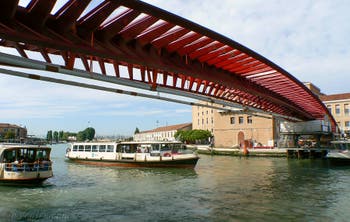
Constitution Bridge Architect Santiago Calatrava's bridge in Venice, which has been christened the Constitution Bridge (ponte della Costituzione) was inaugurated on 11 September 2008 at 23:44... on the sly and therefore in the middle of the night to, officially, avoid demonstrations by opponents of the bridge after years of procrastination and work stretching on endlessly since the project had been launched by the municipality of Venice in November 1999.
When you consider that the Rialto Bridge was built in two years, more than four centuries ago, it makes you think...
Its general line and curve are quite pretty, modern without being futuristic.
A variety of materials were used, including tempered glass, manufactured by Saint-Gobain, and Istrian stone, "the material par excellence of Venetian palaces and works of art for centuries.
The handrail on the Calatrava Constitution bridge is made of enamelled bronze, while the parapet is made entirely of glass - beware of vertigo!
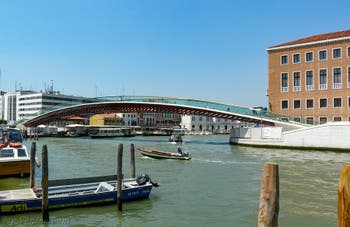
Constitution Bridge The steps and deck of this fourth new bridge over the Grand Canal are made of tempered glass and Istrian stone.
Finally, this new bridge in Venice, officially known as the Constitution Bridge (ponte della Costituzione) but which the Venetians will always call the Calatrava Bridge, is illuminated at night by fluorescent bulbs set into the enamelled bronze handrail.
To complete the "light" effect of this new Venetian bridge, spotlights positioned at the bottom of the walls illuminate the ground on either side of the bridge, while the transparent deck also has lighting located beneath it.
Aesthetics and controversy
Venice has a tradition and culture so rooted in its past that any architectural novelty inevitably lends itself to controversy. In our opinion, this attitude is rather backward-looking.Many of the buildings in Venice were built after the old ones were demolished, even if they were still in good condition.
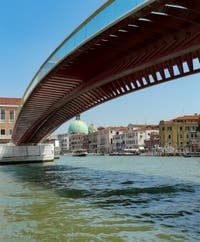
Constitution Bridge We simply wanted to "do something new" something we no longer dare to do here today.
Who today would be offended by the presence on the Grand Canal of the Ca d'Oro, one of Venice's most beautiful palaces? And yet the previous palace was completely demolished to build it.
We're all in awe of the mosaics in the Basilica of St. Mark. Yet, with rare exceptions, they are no longer the original mosaics at all.
Our Venetian ancestors rarely repaired the mosaics in the famous church. A few bits were glued back together from time to time, but more often than not, when a mosaic began to deteriorate too much, it was removed altogether and the opportunity taken to lay a new one with a motif more in keeping with "the taste of the day", a "modern" from the 15th century, and everyone thought that was great.
You will also have seen "pieces" of Byzantine architecture (arches, engraved stones...) or even less ancient architecture emerging in certain facades of houses and palaces: existing structures and stones were salvaged and here too, everyone was happy to be able to rebuild a "modern" house or palace.

Bridge of the Constitution In short, in our view the aesthetic polemic is more a reflection of the backward-looking nature of certain minds than of any real risk of the new Santiago Calatrava bridge disfiguring Venice.
And between you and me, it's hard to see how the new Venice Bridge could succeed in disfiguring a place as ugly as Piazzale Roma and the brick buildings that the bridge connects to on the other side of the Grand Canal.
On the contrary, you might even think that it aesthetically improves the very "industrial" and cold side of this district.
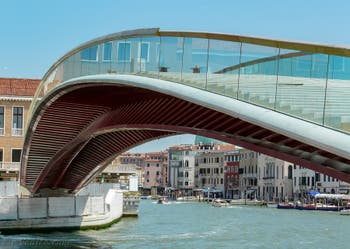
Constitution Bridge
Technical prowess
We have to salute the technical feat, as the metal structure of this bridge has a total length of 94 metres and 9 metres wide in the middle, and overhangs the Grand Canal at 9.28 metres at its central point.An additional 156 blocks of Istrian stone have been incorporated, adding to a steel structure weighing 420 tonnes.
Finally, a huge advantage over the existing Scalzi bridge near Santa Lucia station, the new Santiago Calatrava Constitution bridge has a gondola for disabled people or those with mobility difficulties (still not in service).
"Senza Nome" that's what some places in Venice are called, and that's what happened to the Constitution Bridge, the bridge that everyone called until it was inaugurated: Ponte Calatrava, after its architect Santiago Calatrava.

Constitution Bridge The newspaper Il Gazzettino had launched a polling procedure among Venetians but nothing specific came out of it apart from a few proposals of the type "costs too much" or, aimed at its disputed usefulness and with much humour, the bridge "comes and goes".
A few very Venetian names had been suggested by the Commune of Venice, but keeping things simple and consensual is often rather difficult here... so in the end we opted for the simplest and least original possible by christening this Calatrava bridge the Constitution Bridge.
The reason for naming the bridge the Constitution Bridge is that its name will symbolically link it with the bridge that links Venice to the mainland: the Liberty Bridge.
A Dangerous Bridge?
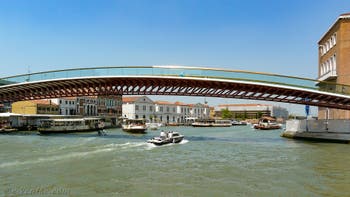
Constitution Bridge It has to be said that the bridge's steps were bizarrely designed for a pedestrian bridge.
Their height is too low and their depth, which varies depending on where you are on the bridge, means that it is often difficult to alternate your steps.
Variations in the depth of the steps are also the cause of many falls by users.
It's tempting to look at the view over Venice as you walk along.
And that's where the danger lies: as the flights of steps are not regular, you miss one and fall.
So take care when using this bridge!
A fragile bridge?
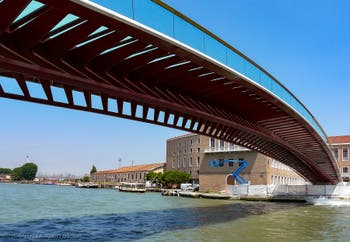
Constitution Bridge The rules governing traffic on Venice's Ponte della Costituzione give one pause for thought.
It is in fact forbidden to carry suitcases or other wheeled trolleys weighing more than 20 kilos and/or a maximum of one cubic metre.
The ponte della Costituzione is a major traffic artery in Venice. Its maintenance costs the Venetians a fortune because the base of the bridge and the bridge itself move abnormally, beyond the usual tolerances.
This means that the bridge is under constant surveillance, with annual maintenance and inspection costs running into hundreds of thousands of euros.
Back to Top of Page

